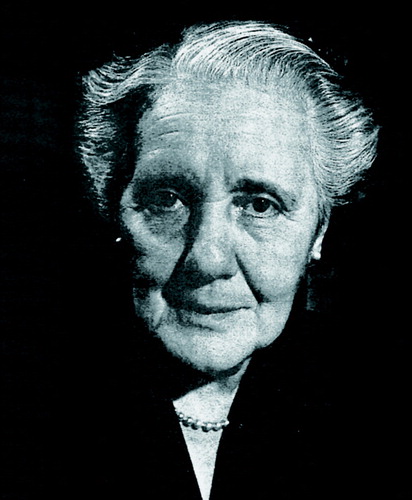Melanie Klein, 1882–1960
Melanie Klein was born in Vienna in 1882. She married Arthur Klein in 1903 and bore him three children—two boys and a girl. She was first analyzed by Ferenczi, who encouraged her to start analyzing children, and she read her first paper to the Hungarian Psychoanalytic Society in 1919 on “The Development of the Child.” She underwent further analysis with Karl Abraham in 1924 in Berlin. In 1925, she lectured on child analysis in London and, with encouragement from Ernest Jones, settled in London in 1926 where she remained working, teaching, and writing until her death in 1960. Her contributions to child and adult analysis were numerous and original, and many analysts believe that she was second only to Freud in overall importance to both the science and the art of psychoanalysis.
Melanie Klein adhered to strict orthodox technique in the psychoanalysis of children. This was at variance with contemporary practice, even with the work of Anna Freud. She used small toys to facilitate her work and demonstrated that all behavior, play, drawing, and even silence had a latent content of unconscious fantasy that could be interpreted in the same way as verbal communications and dreams. This understanding not only made the analysis of small children possible but also opened the door to the understanding and analysis of the nonverbal communication of all patients, including those with psychosis and borderline personality disorder.
Klein posited that for development to proceed along healthy lines, the infant has to initially split its external world, objects, and itself into two categories: good (i.e., gratifying, loved, loving, etc.) and bad (frustrating, hated, persecutory, etc.) and to introject and identify with the good. This would sustain the infant against the onslaught of the bad. Later, when the ego had developed sufficiently, the bad could be integrated, and ambivalence and conflict could be tolerated. She described development as proceeding through two phases that she called the paranoid-schizoid position and the depressive position. In the paranoid-schizoid position, the main anxiety is paranoia and hypochondriasis, and the fear is for the self (narcissistic pathologies). In the depressive position, the leading anxiety is about destruction and loss of the object (manic and perverse pathologies).
Klein described how development depended on introjection and projection which, like eating and breathing, went on from birth. As a consequence of early projective and introjective processes, a super-ego—more primitive than Freud’s Oedipal super-ego—is formed that plays a major role in the psychoses, manic-depressive illness, and paranoia. She outlined in detail an omnipotent fantasy she labeled projective identification, which plays a major role in all the developmental processes, normal as well as pathologic.
Klein differentiated jealousy, i.e., pain related to loss of love in a three-person relationship, from envy, i.e., pain related to disparity in capacity and possessions in a two-person relationship. She also showed how envy could be stimulated by gratification as well as frustration. Her formulations concerning early envy and its role in limiting therapeutic success have helped the treatment of the most intractable patients. Klein"s psychoanalytic work and discoveries have stimulated an important school of thought and analysis. Her analysands—Bion, Joseph, Meltzer, Rosenfeld, and Segal among others—have produced over 100 books containing significant contemporary thought and advances in analytic theory and technique.
Address reprint requests to Dr. Mason, 450 N. Bedford Dr. #305, Beverly Hills, CA 90210

Melanie Klein



